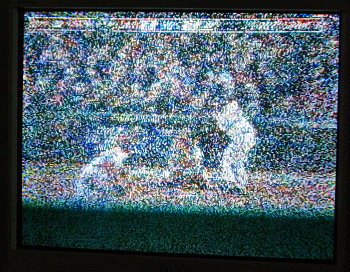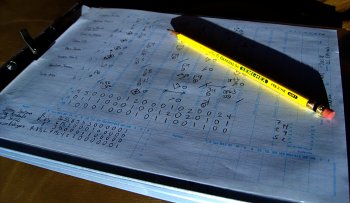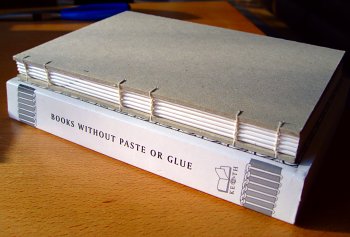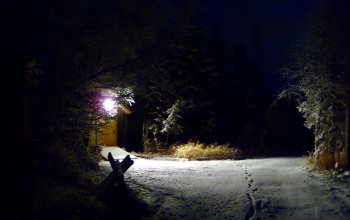
os x firewall tool
One of the more annoying things about Apple’s wireless routers is that there’s no way to shape the bandwidth. With two of us in the house, commonly using the Internet at the same time, and a limited 43 KB/s bandwidth, we wind up stepping on each other’s use fairly often. One bandwidth limiting tool is the Unix command trickle which allows you to control bandwidth on individual, command line programs. Something like:
trickle -u 20 -d 20 wget http://bigfiles.com/bigfile.mp3
would limit the file download to 20 KB/second, about half our our bandwidth. Many commands like wget and rsync have bandwidth limiting built in, making trickle unnecessary for those programs.
These techniques don’t work when the programs don’t include limiting internally, and when you can’t run them from the command line. The program I use to download music from eMusic (eMusicJ) is an example. With my downloads refreshing in a couple days, I wanted to find a way to get my downloads in, without ruining the network for the next day and a half.
Since OS X is built on BSD, it comes with a super-sophisticated firewall, ipfw, that has traffic shaping built in. So here’s how I was able to consume only half of our bandwidth downloading music:
Start the download and use netstat -an to find the IP address of the download site (or do netstat -an before and after you’ve started the download to identify the new download IP Address):
$ netstat -an | less
Active Internet connections (including servers)
Proto Recv-Q Send-Q Local Address Foreign Address (state)
tcp4 0 0 10.0.1.198.54176 38.98.87.100.80 ESTABLISHED
tcp4 0 0 10.0.1.198.54175 38.98.87.100.80 ESTABLISHED
tcp4 0 0 10.0.1.198.54142 38.98.87.100.80 ESTABLISHED
tcp4 0 0 10.0.1.198.54136 38.98.87.100.80 ESTABLISHED
Set up a pipe for data coming from that site:
$ sudo ipfw add pipe 10 ip from 38.98.87.100 to any
00100 pipe 10 ip from 38.98.87.100 to any
Configure the pipe to limit bandwidth:
$ sudo ipfw pipe 10 config bw 20KBytes/s queue 10KBytes
After you're done, delete the pipe:
$ sudo ipfw list
00100 pipe 10 ip from 38.98.87.100 to any
65535 allow ip from any to any
$ sudo ipfw del 00100
Major League Baseball is doing it’s best to ruin my baseball experience this season. I finally gave up on Gameday Audio after all my struggles trying to get it to play smoothly on my MacBook Pro (Windows Media format might work well on Windows, but it frigging sucks everywhere else). Once the piteous spectacle of the NFL started, my local AM radio station stopped broadcasting Sunday Night Baseball (and all the baseball playoff games this Sunday), which was the only opportunity I had to listen to games. And, the first round of the playoffs and half of the second round aren’t on regular television anymore (they’re on TBS).
Turns out that TBS is broadcast over the air on channel 28, but as you can see from the image, it doesn’t come in very well at our house. Despite all that, though, I’m watching and scoring the game. MLB hasn’t completely lost me yet.
Yesterday I got three dozen pencils from General Pencil Company, one of the few remaining pencil manufacturers that still make their pencils in the United States. My favorite pencils had been Dixon Ticonderoga’s, but they’ve moved all their production to foreign countries, including China. Most people probably don’t think much about pencils, but there’s a big difference between a good pencil and a bad one. The crap they sell at office superstores have uneven graphite, poorly centered lead, small erasers, thin paint, are commonly made in China, and probably don’t use sustainably produced wood for the case. Mechanical pencils stay sharp and are refillable, but they just don’t feel as good as a wooden-cased pencil, and I think the environmental impact of a sustainably produced wooden pencil is lower than all the plastic and packaging of mechanical pencils and their supplies.
I got three dozen “Semi-Hex,” #2/HB pencils (number 492-2/HB). I’d never seen a General’s pencil in the store, and never (as far as I know) used one, so this was an experiment to see if I’ve found an American-made replacement for the Ticonderoga. Since it’s baseball playoff time, I tested them out by scoring yesterday’s playoff game between the Boston Red Sox and the California Angels (or whatever they’re calling themselves this year). In this year’s playoffs I’m rooting for the Cubs and Phillies in the National League and the Rays in the American League. But I’m primarily an A’s fan, so a loss by the Angels is always a win for this A’s fan.
The game was a good one (especially since the Angels lost), with a reasonable amount of scoring, and a very exciting ending. And the pencil was fantastic. The lead is very even, with none of the little hard bits you’ll find in a poorly made pencil, it makes a nice dark line, and isn’t so soft that it smudges easily. With the Ticonderoga, I’m torn between the #2 and #2/HB because the HB is just a touch too soft, and the #2 is too hard and doesn’t write well outside because the paper gets softer when it’s humid. The General #2/HB seems slightly harder than the Ticonderoga HB, so I was able to make it through the whole game on one sharpening. I think I’ve found a winner.
Hopefully when I’ve used all three dozen, General will still be making pencils in the U.S.
Note that if you’re interested in learning to score, I’ve got a reasonably complete Guide to Scoring Baseball, and a series of free scorecards you can download and print.
At ABR, we use a notebook (our “black book”) to keep track of what we were doing for the hours we charge to our clients. I’d been using the notebook I made a couple years ago, but ran out of pages on Friday, so today I made another one. The coptic style is really great for this sort of thing because it will lie completely flat on the desk, and there’s no glued binding to break. Yesterday we went to If Only here in town and I almost bought a Moleskine sketchbook, but I put it back on the shelf because I wasn’t sure it’d lay flat. Their normal notebooks will, but the pages are much too thin for fountain pens unless you only write on one side of the page. So often it seems there’s no substitute for doing something yourself so you can make sure it’s done right.
Sigh.
The covers are plain, acid-free book boards that are normally covered with book cloth or leather, but I’ll just slip it into the leather book cover I used with my previous notebook so the boards won’t show until I’m done with the notebook. The paper is Mohawk Superfine, cut into short-grain pages by my supplier, folded into five 32-page sections (8 pieces of paper folded in half = 32 pages), and sewn together with linen thread using a sewing technique that’s several thousand years old. Last time I had trouble doing all the stitching with a straight needle so I bent a needle by heating it red hot over the stove, bending it into a curve, heating it to red hot a second time before quenching it in cold water. The tip could probably use some sharpening after the heat treatment, but it worked well as is.
The whole project took less than two hours and required very few supplies.
We got our first real snowfall last night, about two inches at our place. It probably won’t last (the second week in October is normally when we get the snow that stays until April), but it means the roads will be dangerous for the next couple days or weeks. Last week we saw our first great horned owl of the fall, and the snowshoe hares are rapidly turning white so winter is just about here. We’re hoping for a bunch of early season snowfall this year to get the trails set up for skiing and mushing.
What’s cool about the first snowfall of the year, especially when it’s a lot of snow like last night, is how totally different the world looks. You go to bed and it’s painted in yellows and browns, but when you wake up, it’s all cleaned up in black and white and blue. I know it’ll melt, probably later today and turn brown again, but as the sun comes up on the new wintry world, it feels fresh.
I finished wiring the shed yesterday afternoon. I was surprised at how long it took, but since everything is connected in series, each connection has to be perfect or nothing down the line will work. I’ve lived in enough cabins with funky wiring to know that it’s better to do it right the first time. The shed now has an outlet on each wall, an outdoor GFCI outlet on the outside of the building, a pair of lights in the ceiling, and an outdoor motion-detecting floodlight (that’s what’s lighting the photo on the right). The lights are wired to a switch next to the door. All that’s left is to clean up the inside and build what we need to store stuff in there. We’d planned on painting the floor, but I think it’s too late in the year for that now.



